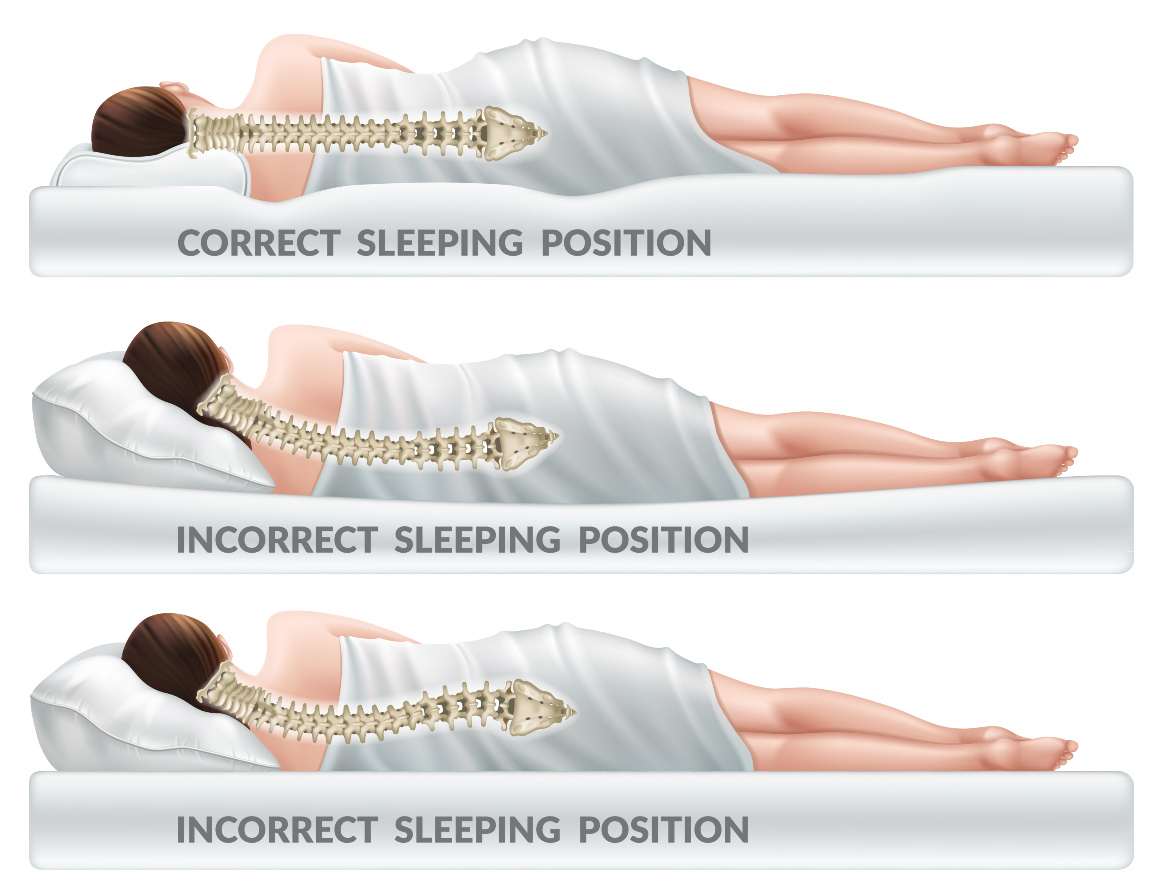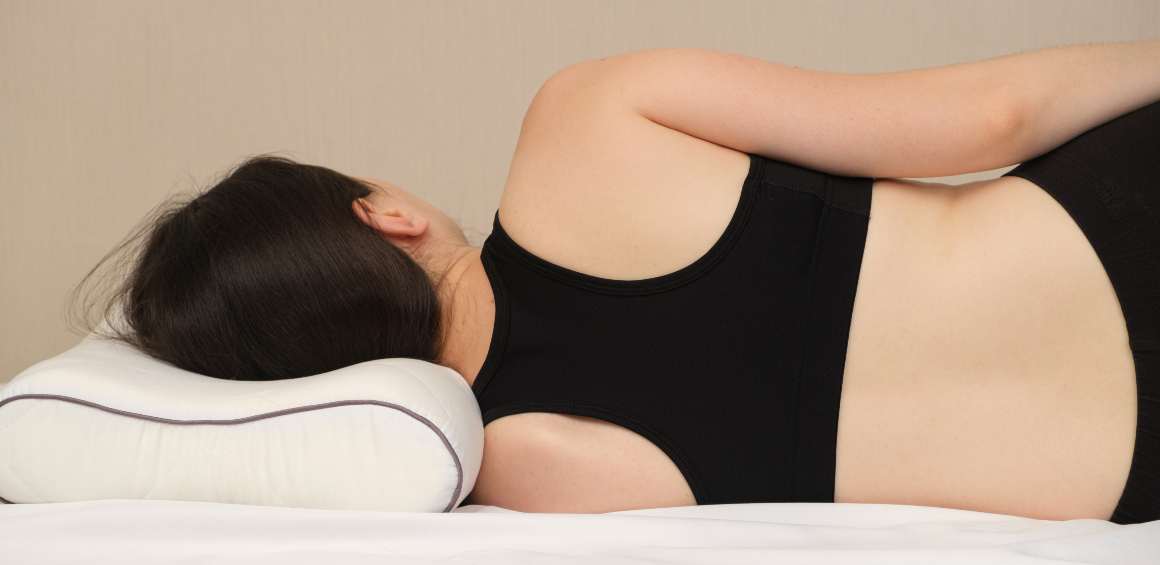Reducing Neck Pain from Sleeping: Tips for Better Rest
Published:
Waking up with neck pain from sleeping can be a frustrating and uncomfortable experience. This common issue may stem from various factors such as sleep positions, pillow types, or sudden movements during the night. In this comprehensive blog post, we will delve into the causes of neck pain and provide practical solutions to alleviate discomfort and prevent future occurrences.
Contents:
- Identifying Causes of Neck Pain from Sleeping
- Adjusting Sleep Positions for Optimal Support
- Choosing the Right Pillow Type
- Maintaining Proper Posture During Waking Hours
- Temporary Relief Methods for Neck Pain from Sleeping Wrong
- Seeking Professional Help if Neck Pain Persists
- FAQs in Relation to Neck Pain From Sleeping
- Conclusion
As you read on, you'll discover how adjusting your sleep position can benefit spinal health and reduce pressure points. We will also discuss choosing the right pillow for optimal head and neck support, which is crucial in preventing chronic pain.
In addition to addressing nighttime habits, maintaining proper posture during waking hours plays a significant role in overall spine health. Our expert tips on improving standing and sitting posture will prove invaluable for those seeking long-term relief.
If morning neck pain persists despite these preventative measures, temporary relief methods such as cold therapy applications or gentle stretching exercises may help manage symptoms until professional care is sought out. Lastly, we explore physical therapy benefits alongside chiropractic care options and acupuncture as alternative treatment approaches for persistent neck pain from sleeping.

Identifying Causes of Neck Pain from Sleeping
Understanding the various factors that contribute to neck pain while sleeping is essential for finding relief and preventing future occurrences. These factors may include your sleep position, pillow type, sudden movements during sleep, poor posture throughout the day, or sports injuries. In this section, we will discuss some common causes of neck pain and provide helpful tips on how to address them.
Sleep Position
Positioning while sleeping is a key factor in whether neck pain occurs or not. The three primary postures for sleeping are on one's back, side, and abdomen. Stomach-sleepers often suffer from neck pain due to unnatural alignment throughout the night; changing your sleep position by lying on your side or back can help maintain proper spinal alignment and reduce discomfort.
Pillow Type
The type of pillow you use also affects the likelihood of experiencing neck pain while asleep. A good quality pillow should provide adequate support for your head and neck without causing strain on muscles or joints. Feather pillows offer customized support as they conform to the shape of these areas ensuring optimal comfort while reducing strain on muscles whereas memory foam pillows have a contouring effect that adapts well with different body shapes.
Sudden Movements During Sleep
Tossing and turning at night can lead to abrupt changes in head positioning which might result in muscle strains or pinched nerves around the cervical spine area - both leading contributors towards developing chronic neck pain. To prevent such issues try practicing relaxation techniques like deep breathing exercises before bedtime as it helps calm down an overactive mind allowing for more restful slumber sessions.
Poor Posture Throughout the Day
Adopting poor posture habits during waking hours can lead to increased neck pain while sleeping. Slouching, hunching over electronic devices, and carrying heavy bags on one shoulder are all common culprits that contribute to muscle imbalances and tension in the neck area. To improve your posture, focus on standing up straight with hands at sides when walking or standing still; hold electronic devices at eye level instead of looking down at them; sit upright without slouching forward onto desks.
Sports Injuries
Neck injuries sustained during sports activities like whiplash from contact sports or repetitive strain injuries from swimming can cause persistent discomfort even after healing has occurred - this is because scar tissue formation around injured areas often leads to reduced flexibility along affected muscles making them more susceptible towards developing chronic pain issues later down the line. For optimal results, it is recommended to seek medical advice if you believe your neck pain may be caused by a sports-related injury; such treatment options could include physical therapy or chiropractic care.

Adjusting Sleep Positions for Optimal Support
One major contributor to neck pain is an improper sleeping position. Sleeping on your stomach strains both your neck and back due to unnatural alignment throughout the night. Changing your sleep position by lying on your side or back can help maintain proper spinal alignment and reduce discomfort. In this section, we will discuss the benefits of two recommended positions: side-sleeping with a supportive pillow between legs and back-sleeping with a small pillow under knees.
Side-sleeping with a supportive pillow between legs
Side sleepers often experience less neck pain compared to those who sleep on their stomachs because it allows for better spine alignment. However, placing a supportive pillow between your legs can further enhance comfort and prevent additional strain on the lower back and hips. This extra support helps keep the pelvis level while you rest, ensuring that pressure is evenly distributed across joints and muscles.
- Select a firm yet comfortable pillow designed specifically for side sleepers.
- Place it between your knees when lying down in bed.
- The height of the pillow should be sufficient enough to keep both legs parallel without causing any discomfort or muscle tension in either leg.
Back-sleeping with a small pillow under knees
If you prefer sleeping on your back, using a small cushion beneath your knees can provide significant relief from potential neck pain as well as alleviate any existing symptoms related to chronic back pain. Elevating the knees slightly can help to reduce pressure on the lower back area, creating a more natural curvature and offering improved support.
- Choose a small pillow or cushion specifically designed to provide adequate support under your knees.
- Place it beneath both knees when lying down in bed. The height should be enough to elevate them slightly without causing any discomfort or muscle tension in either leg.
In addition to adjusting your sleep position, it's essential to consider other factors that may contribute to neck pain while sleeping. These include using an appropriate pillow type, maintaining proper posture during waking hours, and seeking professional help if necessary. Taking preventative measures can help minimize neck discomfort and bolster your sleep quality.

Choosing the Right Pillow Type
The type of pillow you use plays a significant role in providing adequate support for your head and neck during sleep. Using feather or memory foam pillows that conform to the shape of these areas ensures optimal comfort while reducing strain on muscles. In this piece, we will explore the advantages of feather and memory foam pillows to help you make a knowledgeable choice when picking the ideal pillow for restful sleep.
Feather Pillows for Customized Support
Feather pillows are known for their softness and ability to mold to your head and neck contours, providing customized support throughout the night. They can be easily fluffed up or flattened down according to individual preferences, making them ideal for those who frequently change positions during sleep. Additionally, they offer excellent breathability due to their natural materials, ensuring that you stay cool even on warmer nights.
- Easily adjustable: Feather pillows can be reshaped as needed based on personal preference.
- Breathable: The natural materials allow air circulation which helps regulate temperature during sleep.
- Durable: With proper care, high-quality feather pillows can last several years before needing replacement.
Memory Foam Pillows for Contouring Effect
Memory foam pillows, made from viscoelastic polyurethane material originally developed by NASA scientists in response to astronauts' needs in space travel missions, have gained popularity among side sleepers seeking relief from chronic pain issues such as neck pain or back pain. These pillows are designed to contour and mold around your head, neck, and shoulders, providing optimal support while reducing pressure points. They also help maintain proper spinal alignment throughout the night.
- Pressure-relieving: Memory foam conforms to your body shape, distributing weight evenly and minimizing pressure on sensitive areas.
- Supportive: The material provides adequate support for both side sleepers and back sleepers by maintaining proper spinal alignment during sleep.
- Hypoallergenic: Many memory foam pillows come with hypoallergenic covers that can be removed and washed easily for a clean sleeping environment.
In conclusion, choosing the right pillow type is essential in preventing neck pain from sleeping. Feather pillows offer customized support with their adjustable nature while memory foam pillows provide contouring effects that relieve pressure points. Consider factors such as personal preferences, allergies, or sensitivities to materials when selecting a pillow that best suits your needs. A good night's rest starts with making informed decisions about what supports you during those precious hours of slumber.

Maintaining Proper Posture During Waking Hours
Good posture while awake is crucial in preventing overnight development of neck pain. By keeping your body aligned throughout the day, you can lessen tension on your muscles and guarantee a more peaceful sleep. In this section, we will discuss correct standing posture techniques, tips for avoiding "text-neck" syndrome, and ways to improve overall posture during daily activities.
Correct Standing Posture Techniques
To maintain good standing posture, follow these simple steps:
- Stand up straight with feet shoulder-width apart.
- Distribute your weight evenly between both feet.
- Tuck in your pelvis slightly to prevent an exaggerated curve in the lower back.
- Pull your shoulders back and down away from your ears.
- Keep your head level by imagining a string pulling it upward toward the ceiling.
Practicing good standing posture not only helps prevent neck pain but also reduces stress on other joints such as hips, knees, and ankles. Additionally, it promotes better circulation and digestion due to improved body alignment.
Tips for Avoiding "Text-Neck" Syndrome
"Text-neck" syndrome refers to the strain caused by constantly looking down at electronic devices like smartphones or tablets. To avoid developing this condition that contributes to neck pain:
- Raise the device so that it is at eye level when using it; consider investing in a phone holder or stand if necessary.
- Avoid prolonged periods of device usage without breaks; set a timer to remind yourself to take breaks and stretch.
- Perform neck stretches throughout the day, such as tilting your head side-to-side or gently pulling it toward each shoulder.
By implementing these tips, you can reduce strain on your neck muscles and prevent pain from developing due to poor posture while using electronic devices.
Improving Overall Posture During Daily Activities
In addition to standing posture and avoiding "text-neck" syndrome, consider making adjustments in other areas of daily life:
- Sitting: Sit upright with both feet flat on the floor. Use a lumbar roll or cushion for lower back support if needed. Avoid crossing your legs or sitting on one foot, which can cause misalignment.
- Lifting: When lifting heavy objects, bend at the knees instead of the waist. Keep items close to your body when carrying them.
- Sleeping: As mentioned earlier in this article, choose an appropriate pillow type that supports proper spinal alignment during sleep. Additionally, avoid sleeping on your stomach as it strains both neck and back muscles.
Maintaining good posture throughout all aspects of daily life is essential for preventing neck pain caused by improper alignment during sleep. By implementing these strategies consistently over time, you will not only experience less discomfort but also improve overall health and well-being.

Temporary Relief Methods for Neck Pain from Sleeping Wrong
If you wake up experiencing soreness despite making necessary adjustments, there are several methods available to provide temporary relief. These techniques can help reduce inflammation, alleviate muscle tension, and promote healing.
Cold Therapy for Reducing Inflammation
Applying ice packs wrapped in cloth directly onto the affected areas can help reduce inflammation and numb pain. It's important to avoid applying ice directly on your skin as it may cause frostbite or irritation. Instead, wrap an ice pack or a bag of frozen peas in a thin towel before placing it on your neck. Apply cold therapy for 15-20 minutes every hour during the first 24 hours after noticing neck pain.
Over-the-counter Medications for Pain Relief
Taking over-the-counter medications like NSAIDs (ibuprofen) along with acetaminophen-based products (Tylenol) can help manage pain and reduce inflammation. However, always consult with a healthcare professional before starting any new medication regimen and follow the recommended dosage instructions provided by the manufacturer.
Gentle Neck Stretches and Shoulder Rolls
- Neck Tilts: Slowly tilt your head forward until your chin touches your chest; hold this position for five seconds then return to neutral position. Repeat this exercise three times.
- Lateral Neck Stretch: Gently tilt your head towards one shoulder without lifting the opposite shoulder; hold this stretch for about 10 seconds then repeat on the other side.
- Shoulder Rolls: Stand or sit upright and slowly roll your shoulders forward in a circular motion, then reverse the direction and roll them backward. Repeat this exercise five times in each direction.
These gentle stretches and exercises can help alleviate muscle tension and improve flexibility. Remember to perform these movements slowly and stop if you experience any sharp pain or discomfort.
Relaxation Techniques to Alleviate Muscle Tension
Situating yourself in a relaxed state, such as through mindfulness meditation or deep breathing, may be beneficial to reducing stress levels and consequently neck pain. Here are two simple methods:
- Mindfulness Meditation: Sit comfortably with your back straight, close your eyes, and focus on your breath as it flows in and out of your body. If thoughts arise, gently bring your attention back to the breath without judgment.
- Deep Breathing Exercise: Inhale deeply through your nose for four seconds; hold the breath for another four seconds; exhale slowly through pursed lips for eight seconds. Repeat this cycle several times until you feel more relaxed.
Incorporating these temporary relief methods into your daily routine can provide some comfort while you work towards long-term solutions for preventing neck pain from sleeping wrong. Side sleepers may want to consider changing their sleeping position to reduce neck pain and chronic pain.
Seeking Professional Help if Neck Pain Persists
If your neck pain continues despite making adjustments, it's essential to consult a healthcare professional. They may recommend additional treatments such as physical therapy, massage, chiropractic care, acupuncture, or even prescription medications in more severe cases.
Physical Therapy Sessions for Targeted Treatment
A licensed physical therapist will evaluate your condition and create a tailored treatment plan that involves exercises aimed at alleviating pain, reducing inflammation, and improving posture. A licensed physical therapist will assess your condition and develop a personalized treatment plan that includes exercises designed specifically for you. These exercises aim to reduce pain and inflammation while promoting proper posture and alignment.
Chiropractic Care to Realign the Spine
Chiropractic care is another option for those experiencing persistent neck discomfort due to misalignment of the spine or other musculoskeletal issues. Chiropractors use manual manipulation techniques to realign vertebrae in your cervical spine (neck) which can help alleviate pressure on nerves causing discomfort. Regular chiropractic adjustments have been shown not only to provide relief from neck pain but also improve overall spinal health.
Acupuncture as an Alternative Approach
Acupuncture, a traditional Chinese medicine technique, involves inserting thin needles into specific points on the body to promote healing and reduce pain. Some studies have shown that acupuncture can be an effective treatment for neck pain by stimulating the release of endorphins (natural pain-relieving chemicals) in your brain. Many find acupuncture a beneficial adjunct to other treatments for neck pain.
It is essential to keep in mind that the efficacy of treatments for neck pain may vary between individuals. Discuss any potential treatments with your healthcare provider before deciding which approach is most suitable for you.
In addition to seeking professional help if necessary, there are several lifestyle changes you can make at home to improve your posture and prevent future episodes of neck discomfort from sleeping wrong:
- Maintain proper ergonomics while working at a desk or computer
- Avoid cradling your phone between your shoulder and ear
- Take regular breaks throughout the day to stretch and move around
- Consider incorporating yoga or Pilates exercises into your routine to strengthen core muscles supporting good posture
Taking these proactive steps along with consulting a healthcare professional when needed will put you on the path toward reducing persistent neck pain caused by poor sleep habits.
FAQs in Relation to Neck Pain From Sleeping
What helps neck pain from sleeping badly?
To alleviate neck pain from sleeping poorly, try adjusting your sleep position to either side-sleeping or back-sleeping for better spinal alignment. Choose a pillow that provides proper support, such as memory foam or feather pillows. Additionally, maintain good posture during waking hours and consider temporary relief methods like cold therapy, gentle stretching exercises, and relaxation techniques.
Why do I keep getting neck pain from sleeping?
Persistent neck pain while sleeping may be caused by factors such as improper sleep positions affecting spinal alignment, using unsuitable pillows that don't provide adequate head and neck support, sudden movements leading to muscle strains or sprains. Address these issues by modifying your sleep habits and seeking professional help if necessary through physical therapy, chiropractic care or acupuncture treatments.
Conclusion
In conclusion, neck pain from sleeping can be caused by various factors such as sleep positions, pillow types, sudden movements, and poor posture. Adjusting your sleep position for optimal comfort and choosing the right pillow for neck support are two effective ways to prevent morning neck pain. Additionally, maintaining proper posture during waking hours and utilizing temporary relief methods like cold therapy or gentle stretching exercises can also help alleviate symptoms.
If you experience persistent neck pain from sleeping despite trying these methods, seeking professional help from a physical therapist or chiropractor may provide long-term relief. Acupuncture is another alternative treatment option that may be worth exploring.













